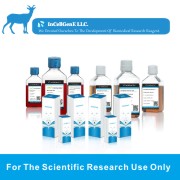

Overview
| Organism | Homo sapiens, human |
|---|---|
| Tissue | kidney |
| Product Format | frozen |
| Culture Properties | adherent |
| Biosafety Level |
2 [Cells contain adenovirus and CMV viral sequences]
Biosafety classification is based on U.S. Public Health Service Guidelines, it is the responsibility of the customer to ensure that their facilities comply with biosafety regulations for their own country. |
| Disease | Leukemia |
| Age | fetus |
| Applications |
The ProPak packaging cell lines produce either murine leukemia virus (MLV) xenotropic particles (ProPak-X cells;ATCC CRL-12007) or amphotropic particles (ProPak-A cells;ATCC CRL-12006 and ATCC CRL-12479).
They were derived from the human embryonic kidney line, 293 (see ATCC CRL-1573).
They secrete defective (non-infectious) murine leukemia virus (MLV) particles composed of gag-pol and env proteins.
A vector that consistently gives rise to replication-competent retrovirus (RCR) in PA317 cells never results in detectable RCR in ProPak-A-based producer cultures.
ProPak-based producer cells were demonstrated to be free of replication-competent retrovirus (RCR) by stringent testing.
Consistently higher transduction of target cells was achieved with ProPak-derived amphotropic vector than with PA317-packaged amphotropic vector.
|
| Storage Conditions | liquid nitrogen vapor phase |
| Disclosure | This material is cited in a US or other Patent and may not be used to infringe the claims. Depending on the wishes of the Depositor, ATCC may be required to inform the Patent Depositor of the party to which the material was furnished. This material may not have been produced or characterized by ATCC. |
Properties
| Derivation |
They were derived from the human embryonic kidney line, 293 (see ATCC CRL-1573).
Consistently higher transduction of target cells was achieved with ProPak-derived amphotropic vector than with PA317-packaged amphotropic vector.
|
|---|---|
| Comments |
The ProPak packaging cell lines produce either murine leukemia virus (MLV) xenotropic particles (ProPak-X cells;ATCC CRL-12007) or amphotropic particles (ProPak-A cells;ATCC CRL-12006 and ATCC CRL-12479).
They were derived from the human embryonic kidney line, 293 (see ATCC CRL-1573).
To derive the amphotropic packaging cell line ProPakA.6, the pCMVEa plasmid was introduced into 293 cells by co-transfection with the pHA58 plasmid conferring resistance to hygromycin B (250 mg/ml).
Clones were subsequently transfected with gag-pol and vector plasmids.
Next, the pCMV-gp construct was stably transfected into the 293-Env clones by cotransfection with the plasmid pSV2pac.
The cells are puromycin-resistant (1 mg/ml). They secrete defective (non-infectious) murine leukemia virus (MLV) particles composed of gag-pol and env proteins.
ProPak-A is a stable amphotropic packaging cell line in which the Gag-Pol and Env (packaging) functions are expressed separately from a heterologous (non-MLV) promoter, to maximally reduce homology between packaging and vector sequences
A vector that consistently gives rise to replication-competent retrovirus (RCR) in PA317 cells never results in detectable RCR in ProPak-A-based producer cultures.
ProPak-based producer cells were demonstrated to be free of replication-competent retrovirus (RCR) by stringent testing.
Consistently higher transduction of target cells was achieved with ProPak-derived amphotropic vector than with PA317-packaged amphotropic vector.
The highest transduction of human hematopoietic progenitor cells was achieved with vector supernatant generated from a coculture of the ProPak-X and ProPak-A cell lines.
|
Background
| Complete Growth Medium |
The base medium for this cell line is ATCC-formulated Dulbecco''s Modified Eagle''s Medium, Catalog No. 30-2002. To make the complete growth medium, add the following components to the base medium: fetal bovine serum to a final concentration of 10%. |
|---|---|
| Subculturing |
Volumes used in this protocol are for 75 cm2 flask; proportionally reduce or increase amount of dissociation medium for culture vessels of other sizes.
Subcultivation Ratio: 1:4 to 1:10 Note: For more information on enzymatic dissociation and subculturing of cell lines consult Chapter 10 in Culture of Animal Cells, a Manual of Basic Technique by R. Ian Freshney, 3rd edition, published by Alan R. Liss, N.Y., 1994. |
| Cryopreservation |
Complete growth medium described above supplemented with 5% (v/v) DMSO. Cell culture tested DMSO is available as ATCC Catalog No. 4-X. |
| Culture Conditions |
Temperature: 37��C
Atmosphere: Air, 95%; Carbon dioxide (CO2), 5%
|


